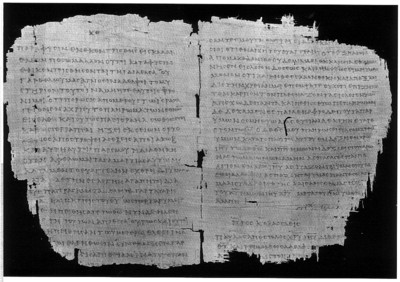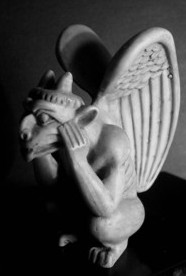Speaking of libraries -- or at any rate of librarians -- I dropped into the Chester Beatty Library during the week.
I know, you've probably never heard of it. That's often the way. There's more to Dublin than drunkenness, you know. Whenever people tell me that they're coming over, and they ask if there's anything in Dublin they really mustn't miss, they tend to blink in confusion when I skip over Temple Bar, the Jameson Distillery, and the Guinness Storehouse -- although I'll recommend the latter solely for the view -- and reel off Dublin's real highlights.
The Chester Beatty Library, currently situated in the Clock Tower of Dublin Castle, used to be based out in Ballsbridge, on the Shrewsbury Road, a road which certainly had and to my knowledge still has the distinction of being the most expensive place on the Irish Monopoly board. It was the private collection of Sir Alfred Chester Beatty, an American mining magnate who moved to Ireland in 1950 and became our first honorary citizen in 1957. His collection of manuscripts, books, prints, paintings, statues and all sorts of other things was put on show in 1954, and left to the state on his death in 1968.
The top floor of the Library is devoted to its Sacred Traditions Gallery, housing texts, manuscripts, and miniature paintings from various religious traditions - notably Christianity, Islam, and Buddhism, but also Confucianism, Taoism, Sikhism, and Jainism. If you take your time there you may well spot a few Muslim depictions of Muhammed which long predate the modern sensitivity to showing his face. From a Christian -- or even more generally Western -- viewpoint, the real jewels in the collection, albeit not the most beautiful, are the Biblical Papyri.
I know, you've probably never heard of it. That's often the way. There's more to Dublin than drunkenness, you know. Whenever people tell me that they're coming over, and they ask if there's anything in Dublin they really mustn't miss, they tend to blink in confusion when I skip over Temple Bar, the Jameson Distillery, and the Guinness Storehouse -- although I'll recommend the latter solely for the view -- and reel off Dublin's real highlights.
The Chester Beatty Library, currently situated in the Clock Tower of Dublin Castle, used to be based out in Ballsbridge, on the Shrewsbury Road, a road which certainly had and to my knowledge still has the distinction of being the most expensive place on the Irish Monopoly board. It was the private collection of Sir Alfred Chester Beatty, an American mining magnate who moved to Ireland in 1950 and became our first honorary citizen in 1957. His collection of manuscripts, books, prints, paintings, statues and all sorts of other things was put on show in 1954, and left to the state on his death in 1968.
The top floor of the Library is devoted to its Sacred Traditions Gallery, housing texts, manuscripts, and miniature paintings from various religious traditions - notably Christianity, Islam, and Buddhism, but also Confucianism, Taoism, Sikhism, and Jainism. If you take your time there you may well spot a few Muslim depictions of Muhammed which long predate the modern sensitivity to showing his face. From a Christian -- or even more generally Western -- viewpoint, the real jewels in the collection, albeit not the most beautiful, are the Biblical Papyri.
 In 1931 The Times reported that Alfred Chester Beatty had come into possession of a substantial number of Greek papyri, three of which contained significant portions of New Testament texts. The papyri are almost certainly Egyptian and can be confidently dated to the early Third Century, perhaps even earlier. Codices rather than scrolls -- the codex, a primitive form of book, seems to have been invented in the late First Century -- the three main Christian ones are usually referred to as P45, P46, and P47.
In 1931 The Times reported that Alfred Chester Beatty had come into possession of a substantial number of Greek papyri, three of which contained significant portions of New Testament texts. The papyri are almost certainly Egyptian and can be confidently dated to the early Third Century, perhaps even earlier. Codices rather than scrolls -- the codex, a primitive form of book, seems to have been invented in the late First Century -- the three main Christian ones are usually referred to as P45, P46, and P47.None of the codices is complete, but all three are of priceless importance. P47 contains ten leaves from the Book of Revelation, containing chapters 9-17, and is by a long way the most substantial portion of the text of Revelation that has survived on papyrus. P46 , of which 56 pages are in Dublin, 30 being in Michigan, contains most of the texts of St Paul's first letter to the Thessalonians, both of his letters to the Corinthians, and his letters to the Romans, Ephesians, Galatian, and Colossians, as well as the Letter to the Hebrews, the Pauline authorship of which was widely questioned even then. It seems that the second letter to the Thessalonians would have also been included in this codex, as might the letter to Philemon, but that the letters to Timothy and Titus must have been excluded.
In rather worse condition than either of these codices, P45 originally contained the texts of the four gospels and of Acts. As it stands, only 30 pages -- all damaged -- of what may have been a 220-page codex survive.
In rather worse condition than either of these codices, P45 originally contained the texts of the four gospels and of Acts. As it stands, only 30 pages -- all damaged -- of what may have been a 220-page codex survive.
 Two pages from Matthew -- one of which is in Vienna -- are extant, two from John, seven from Luke, six from Mark, and thirteen from Acts. Yes, that's the order in which it's bound, based apparently on the principles that the two gospels written by apostles should precede the two by associates of apostles, and that longer gospels should come before shorter ones.
Two pages from Matthew -- one of which is in Vienna -- are extant, two from John, seven from Luke, six from Mark, and thirteen from Acts. Yes, that's the order in which it's bound, based apparently on the principles that the two gospels written by apostles should precede the two by associates of apostles, and that longer gospels should come before shorter ones.You can get some idea of the condition of the manuscript by looking at the picture, which shows part of Mark -- chapter 8, verses 11-26, if you're curious -- and comparing it to the sections from P46 above, where if you squint and know Greek you can read Romans 11.24-32, the conclusion to Philippians, and the start of Colossians.
Not a line of this is intact.
So why does it matter?
Well, it matters for a few reasons, starting with the fact that tattered and desperately incomplete though it is, it's still the earliest substantial New Testament manuscript that we have. There are older fragments, of course, notably the so-called Rylands Fragment in Manchester, which dates to about 125 AD and which includes part of John 8.31-3, 37-8, but such fragments are really little more than scraps.
P45 can be dated to the first half of the Third Century, as I said, and may well be even older than that; while attempts to date the codex to the First Century have not withstood any scrutiny, a date as early as the mid-Second Century is not implausible. Even if they're as late as the mid-Third Century, though, that still means they're a full century older than the Codex Sinaiticus and the Codex Vaticanus.
In other words, they predate not merely the legalisation and patronage of Christianity under the Emperor Constantine, but the persecutions of Constantine's predecessor Diocletian. And this for me makes them Exhibit A in any refutation of the nonsense spouted by Dan Brown and the lemmings who've lapped up The Da Vinci Code.
The central claim in Brown's novel, on which his entire house of cards is flimsily built, is that:
'Constantine commissioned and financed a new Bible, which omitted those gospels that spoke of Christ's human traits and embellished those gospels that made Him godlike. The earlier gospels were outlawed, gathered up, and burned.'It's by no means the most dramatic or exciting claim in the book, but it's the one upon which everything else he says rests.
As I've hinted before, canonising the New Testament was a slow and messy process, like counterinsurgency warfare, or learning to eat soup with a knife. So it's refreshing, when trying to explain the running battle in the early Church to establish just which books were suitable for proclamation at Mass, to not have to just do the whole spiel about Justin, Marcion, Irenaeus, and so on...
It's nice to be able to gesture towards these documents and gently point out that a century -- if not significantly more -- before Constantine was doing his thing that at least one Christian church in Egypt was confident that the four standard gospels were indeed worth keeping.

1 comment:
I've been to the Chester Beatty library, which made me feel glowingly intelligent after reading your post until it suddenly occurred to me that I've been to the Guinness Storehouse three times. Though the view is marvelous.
Post a Comment